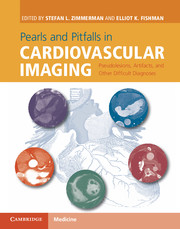 Pearls and Pitfalls in Cardiovascular Imaging
Pearls and Pitfalls in Cardiovascular Imaging from Section 9 - Mesenteric vascular
Published online by Cambridge University Press: 05 June 2015
Imaging description
Pseudoaneurysm, also known as a false aneurysm, is a collection of flowing blood that is encapsulated and communicates with the ruptured arterial lumen contained only by the adventitia or surrounding soft tissue. After contrast administration, the sac may fill with contrast material if it is not completely thrombosed and the enhancement follows that of the feeding artery (Figures 75.1 and 75.2). Thrombus within the sac may appear as high-attenuation filling defect on unenhanced CT or as high-signal-intensity defect on fat-suppressed T1-weighted MR images. Diagnostic specificity may be improved with 3D multidetector CT angiography (Figure 75.3). Three- dimensional renderings are valuable for distinction from tortuous vessel or small, hyperattenuating islet cell tumor of the pancreas. Conventional angiography remains the standard of reference and provides the capability of endovascular management (Figure 75.4).
Importance
Pseudoaneurysms complicate 10% of cases of acute pancreatitis, most commonly affecting the splenic artery, although the hepatic, gastric, gastroduodenal, and pancreaticoduodenal arteries may also be involved due to erosion by pancreatic enzymes. Early detection and management are paramount given the high mortality associated with rupture, which may be up to 90% if bleeding is left untreated. Rupture can occur into the peritoneum, adjacent hollow organs, pseudocyst or pancreatic duct. Given enhancement characteristics, there is risk of mistaking pseudoaneurysms for a hypervascular pancreatic mass such as neuroendocrine tumor. Misdiagnosis leading to biopsy may have catastrophic consequences due to severe bleeding.
Typical clinical scenario
Pseudoaneurysm may be asymptomatic and could be detected incidentally during imaging patients with complicated pancreatitis and may be mistaken for a mass at routine imaging, especially if the lumen is completely thrombosed and fails to enhance on CT. In case of hyperenhancement, it may also be mistaken for a hypervascular lesion such as a neuroendocrine tumor.
To save this book to your Kindle, first ensure no-reply@cambridge.org is added to your Approved Personal Document E-mail List under your Personal Document Settings on the Manage Your Content and Devices page of your Amazon account. Then enter the ‘name’ part of your Kindle email address below. Find out more about saving to your Kindle.
Note you can select to save to either the @free.kindle.com or @kindle.com variations. ‘@free.kindle.com’ emails are free but can only be saved to your device when it is connected to wi-fi. ‘@kindle.com’ emails can be delivered even when you are not connected to wi-fi, but note that service fees apply.
Find out more about the Kindle Personal Document Service.
To save content items to your account, please confirm that you agree to abide by our usage policies. If this is the first time you use this feature, you will be asked to authorise Cambridge Core to connect with your account. Find out more about saving content to Dropbox.
To save content items to your account, please confirm that you agree to abide by our usage policies. If this is the first time you use this feature, you will be asked to authorise Cambridge Core to connect with your account. Find out more about saving content to Google Drive.